 Twenty years ago, when Mary Pope Osborne published the first Magic Tree House book, Dinosaurs Before Dark, she had no idea how successful they would be. She has worked with the same editor, Mallory Loehr, for two decades, and the series has sold more than 100 million copies. Osborne credits teachers with igniting the fire with her fans. As a 20th anniversary gift of thanks to them, the author has launched the Classroom Adventures Program, which she calls "the gift of books and the gift of time." Each book begins with siblings Jack and Annie sent off on a mission via a Magic Tree House they've discovered in the woods in Frog Creek, Pa. The tree house travels back in time, allowing the children to help solve a mystery or aid a historical figure, such as President Abraham Lincoln in the most recent book, Abe Lincoln at Last! Magic Tree House #47. Here Osborne discusses teachers' role in the series' success and outlines her plans to give back to these classroom leaders.
Twenty years ago, when Mary Pope Osborne published the first Magic Tree House book, Dinosaurs Before Dark, she had no idea how successful they would be. She has worked with the same editor, Mallory Loehr, for two decades, and the series has sold more than 100 million copies. Osborne credits teachers with igniting the fire with her fans. As a 20th anniversary gift of thanks to them, the author has launched the Classroom Adventures Program, which she calls "the gift of books and the gift of time." Each book begins with siblings Jack and Annie sent off on a mission via a Magic Tree House they've discovered in the woods in Frog Creek, Pa. The tree house travels back in time, allowing the children to help solve a mystery or aid a historical figure, such as President Abraham Lincoln in the most recent book, Abe Lincoln at Last! Magic Tree House #47. Here Osborne discusses teachers' role in the series' success and outlines her plans to give back to these classroom leaders.
What were the seeds for the Magic Tree House series?
I started writing children's books 10 years before I began writing the Magic Tree House books. Random House suggested I do a series. I thought, "I'll do a little time travel series and then get back to my work." I started getting letters from teachers about how they'd used the books in kindergarten, first grade and second grade. I was so excited I went to 100 schools in three to four years. I got really engaged in education. It sort of took over. For the last five years I've devoted everything to Magic Tree House.
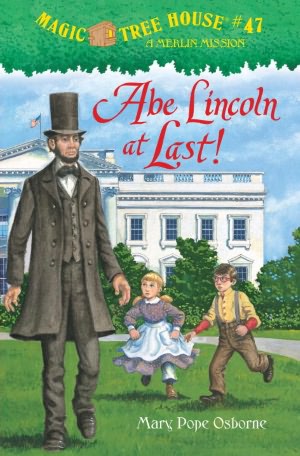 Do you share the research you do for your novels with Natalie for the Fact Trackers?
Do you share the research you do for your novels with Natalie for the Fact Trackers?
Natalie researches for the nonfiction on her own. My research is so private in the way a story evolves for me. I'm outlining and choosing from vast amounts of research, looking for that chemistry of drama, information and excitement.
With Abe Lincoln, I knew I wanted to get into his childhood and also his presidency. I didn't know how I'd get there. Then all the pieces come into play, but they're chosen out of notebooks and notebooks of notes I've taken. There's an alchemy to it, but it's a mystery, and I have to surrender to the process each time.
Right now I'm gathering my materials to research the relationship between Alexander the Great and his horse. I'm planning a trip to go work with horses. My sister will write about great horses the way we did great dog stories [in Dog Heroes].
Had you planned a trajectory for the series from the beginning?
First of all, I was startled at how hard it was to write for second grade. It took a lot more artistry, in a way, than the middle-grade books and YA books I'd written. I was trying to take complex information and get it across simply. In the course of doing that and then hearing from teachers, it became a bigger challenge than I thought it would be. That's what sucked me into doing one contract, then another and another.
The series didn't take off until book 16 or 17. After it took hold, I started having a sense of personal responsibility to kids and teachers and parents that was really strong. I got bushwhacked by second graders.
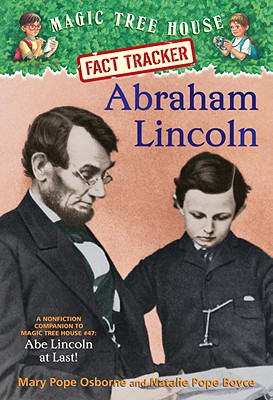 Were the Fact Trackers part of the series from the start?
Were the Fact Trackers part of the series from the start?
I was probably on book 15 or 16, when teachers kept saying, "Oh, we'd love more information." [My husband] Will said, "Let's do a line of nonfiction, so teachers can have companions to the fiction--to teach fiction and nonfiction together." In those days it was called "paired selections." Now a lot of kids who prefer nonfiction will get them at bookstores, but we hoped teachers would use them. We first chose the books we thought teachers need most for curriculum--dinosaurs, ancient Egypt, the rain forest, the moon.
For the last four books, we've introduced the [adventure and the nonfiction title] together. They get double the information off the bat. But that's challenging, too, because you have to think about the story and figure out the nonfiction pairing for it. With the Alexander the Great book, Natalie's already done ancient Greece, so she came up with Horse Heroes.
How did the Classroom Adventures Program begin?
We give an Educator of the Year Award every year, and I've met these teachers over the years who've done such creative things. The Classroom Adventures Program started because we wanted to give books away to schools that couldn't afford them. But when we visited those classrooms, we realized that the teachers didn't know what to do with the books. We thought, "We'll do this program for them." Then it grew to "We'll do this program for everyone."
How will the program work?
It will roll out nationwide; the Web site will launch in the next two weeks. It will supply teachers with three things:
- A curriculum key to the stories and Fact Trackers with regard to how they correlate to subjects they're teaching and the core curriculum standards
- A reading level guide for all the books, which includes: Lexile, Fountas & Pinnell, Guided, DRA, Accelerated Reader Reading Levels and Grade Level Equivalent
- Lesson plans for each book to supplement what teachers are already doing
We have a partnership with First Book to do the actual book distribution. I can buy the books on the marketplace for the schools that qualify for getting them for free. We want to help supplement the goals of curriculum and testing, so it doesn't seem to move teachers or schools off of their mission. We don't want to take them away from the competency scores that teachers have to work with now.
photo of Mary Pope Osborne ©2012 Elena Seibert









 Twenty years ago, when Mary Pope Osborne published the first Magic Tree House book, Dinosaurs Before Dark, she had no idea how successful they would be. She has worked with the same editor, Mallory Loehr, for two decades, and the series has sold more than 100 million copies. Osborne credits teachers with igniting the fire with her fans. As a 20th anniversary gift of thanks to them, the author has launched the
Twenty years ago, when Mary Pope Osborne published the first Magic Tree House book, Dinosaurs Before Dark, she had no idea how successful they would be. She has worked with the same editor, Mallory Loehr, for two decades, and the series has sold more than 100 million copies. Osborne credits teachers with igniting the fire with her fans. As a 20th anniversary gift of thanks to them, the author has launched the  Do you share the research you do for your novels with Natalie for the Fact Trackers?
Do you share the research you do for your novels with Natalie for the Fact Trackers? 
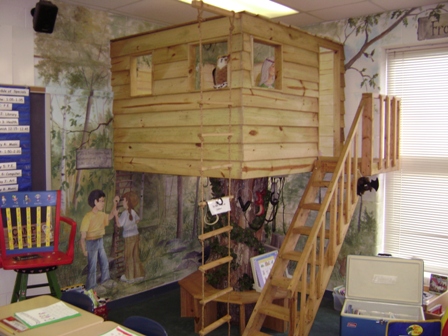
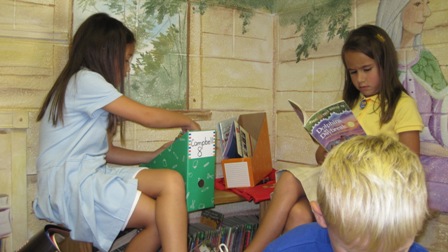 The duo believes it's important to keep building the Magic Tree House library as the school year progresses, and some teachers don't have the budget to do that. Through the Classroom Adventures Program, qualifying schools will be able to request the titles they want, correlating them to their students' interests, and receive them through the partnership with First Book. That's "the gift of books" Osborne mentions. "The second ingredient to the Magic Tree House classroom is the lesson plans," Cirillo said. "That's where the gift of time comes in: downloadable lesson plans from Paula Henson, myself and other teachers across the country. We've put in so much of our own time because we love it, and not every teacher has that time." Henson added, "They can meet these core standards in ways that can get the kids excited."
The duo believes it's important to keep building the Magic Tree House library as the school year progresses, and some teachers don't have the budget to do that. Through the Classroom Adventures Program, qualifying schools will be able to request the titles they want, correlating them to their students' interests, and receive them through the partnership with First Book. That's "the gift of books" Osborne mentions. "The second ingredient to the Magic Tree House classroom is the lesson plans," Cirillo said. "That's where the gift of time comes in: downloadable lesson plans from Paula Henson, myself and other teachers across the country. We've put in so much of our own time because we love it, and not every teacher has that time." Henson added, "They can meet these core standards in ways that can get the kids excited."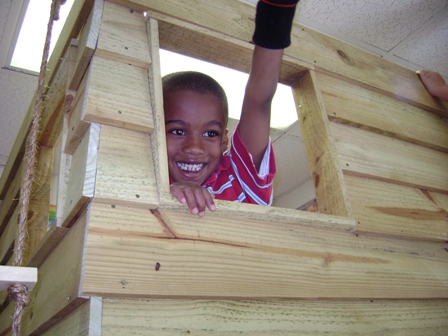 What excites Henson most about the Classroom Adventures Program is the idea of getting this out to teachers who "probably have to buy their own books with their own money," said Henson. Teachers can request specific titles and the Fact Trackers that go with them. She added, "I think it's important to be able to tailor the program to the interests of your students." What most excites Cirillo is the fact that she can share these lessons, and they'll reach students besides her own. "I've seen the difference it's made in my life and my students' lives," Cirillo said. One parent told her, "I don't know what you've done, but you've lit a fire under my son. He reads for an hour after school." Cirillo added, "That's the reward we get, and that gives us the adrenaline rush to burn the candle at both ends to get this done."
What excites Henson most about the Classroom Adventures Program is the idea of getting this out to teachers who "probably have to buy their own books with their own money," said Henson. Teachers can request specific titles and the Fact Trackers that go with them. She added, "I think it's important to be able to tailor the program to the interests of your students." What most excites Cirillo is the fact that she can share these lessons, and they'll reach students besides her own. "I've seen the difference it's made in my life and my students' lives," Cirillo said. One parent told her, "I don't know what you've done, but you've lit a fire under my son. He reads for an hour after school." Cirillo added, "That's the reward we get, and that gives us the adrenaline rush to burn the candle at both ends to get this done."
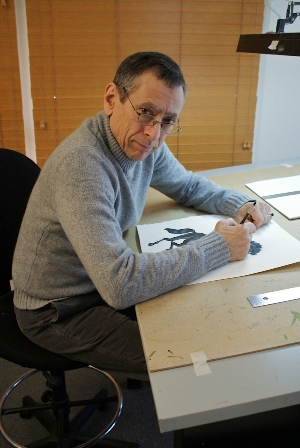 The same is true for Murdocca when he works on a cover, because he completes it far in advance of receiving a manuscript. Often Osborne will suggest a cover image, and Murdocca will come back with a sketch. "She has a great sense of what works," according to Murdocca. "Mary's suggestions are always welcome." For instance, as he works on the cover featuring Alexander the Great and his horse, Bucephalus, for #49--which will be a full-color painting--he's also getting a feel for what part of China will be Jack and Annie's destination for the black-and-white interiors of A Perfect Time for Pandas (#48). All three of them--Osborne, Murdocca and Boyce--do their research independently.
The same is true for Murdocca when he works on a cover, because he completes it far in advance of receiving a manuscript. Often Osborne will suggest a cover image, and Murdocca will come back with a sketch. "She has a great sense of what works," according to Murdocca. "Mary's suggestions are always welcome." For instance, as he works on the cover featuring Alexander the Great and his horse, Bucephalus, for #49--which will be a full-color painting--he's also getting a feel for what part of China will be Jack and Annie's destination for the black-and-white interiors of A Perfect Time for Pandas (#48). All three of them--Osborne, Murdocca and Boyce--do their research independently. Boyce views the research phase not as a duplication of efforts but as a built-in insurance measure. "When we're on the final tracks of our books, [Mary and I] get together by telephone or by email," Boyce said. "We begin to quiz each other. She'll say, 'I don't agree with you about that, can you find something more?' It gives us both the freedom to put our own stamp on things." Boyce backs up her facts with three reputable sources, and an expert relevant to each book also checks for accuracy. An expert at the National Zoo vetted A Perfect Time for Pandas (#48), which will come out in July, and four or five different people examine each title carefully for reading level, factual information and clarity.
Boyce views the research phase not as a duplication of efforts but as a built-in insurance measure. "When we're on the final tracks of our books, [Mary and I] get together by telephone or by email," Boyce said. "We begin to quiz each other. She'll say, 'I don't agree with you about that, can you find something more?' It gives us both the freedom to put our own stamp on things." Boyce backs up her facts with three reputable sources, and an expert relevant to each book also checks for accuracy. An expert at the National Zoo vetted A Perfect Time for Pandas (#48), which will come out in July, and four or five different people examine each title carefully for reading level, factual information and clarity.